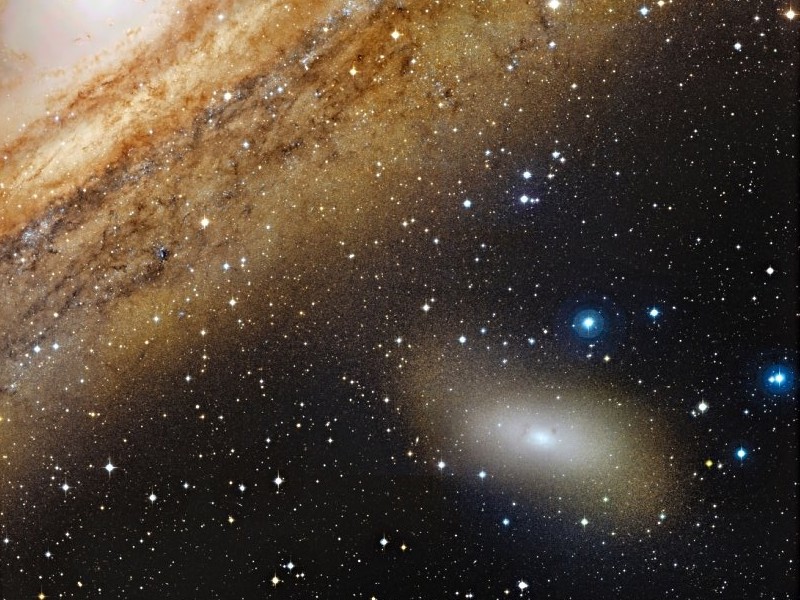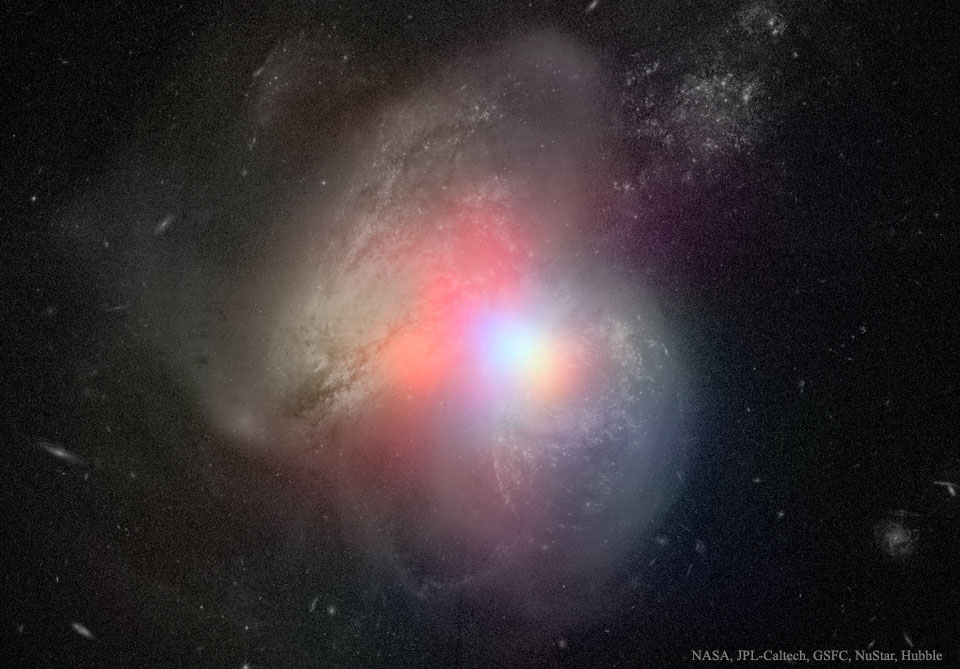SpacestagramBrought to you by NASA’S Astronomy Picture of the Day API
M110: Satellite of the Andromeda Galaxy

2008-09-09
Our Milky Way Galaxy is not alone. It is part of a gathering of about 25 galaxies known as the Local Group. Members include the Great Andromeda Galaxy (M31), M32, M33, the Large Magellanic Cloud, the Small Magellanic Cloud, Dwingeloo 1, several small irregular galaxies, and many dwarf elliptical and dwarf spheroidal galaxies. Pictured on the lower right is one of the dwarf ellipticals: NGC 205. Like M32, NGC 205 is a companion to the large M31, and can sometimes be seen to the south of M31's center in photographs. The image shows NGC 205 to be unusual for an elliptical galaxy in that it contains at least two dust clouds (at 9 and 2 o'clock - they are visible but hard to spot) and signs of recent star formation. This galaxy is sometimes known as M110, although it was actually not part of Messier's original catalog.
Arp 299: Black Holes in Colliding Galaxies

2016-11-01
Is only one black hole spewing high energy radiation -- or two? To help find out, astronomers trained NASA's Earth-orbiting NuSTAR and Chandra telescopes on Arp 299, the enigmatic colliding galaxies expelling the radiation. The two galaxies of Arp 299 have been locked in a gravitational combat for millions of years, while their central black holes will soon do battle themselves. Featured, the high-resolution visible-light image was taken by Hubble, while the superposed diffuse glow of X-ray light was imaged by NuSTAR and shown in false-color red, green, and blue. NuSTAR observations show that only one of the central black holes is seen fighting its way through a region of gas and dust -- and so absorbing matter and emitting X-rays. The energetic radiation, coming only from the galaxy center on the right, is surely created nearby -- but outside -- the central black hole's event horizon. In a billion years or so, only one composite galaxy will remain, and only one central supermassive black hole. Soon thereafter, though, another galaxy may enter the fray. Transparent Science: Browse 1,350+ codes in the Astrophysics Source Code Library
A Large Tsunami Shock Wave on the Sun

2011-09-25
Tsunamis this large don't happen on Earth. During 2006, a large solar flare from an Earth-sized sunspot produced a tsunami-type shock wave that was spectacular even for the Sun. Pictured above, the tsunami wave was captured moving out from active region AR 10930 by the Optical Solar Patrol Network (OSPAN) telescope in New Mexico, USA. The resulting shock wave, known technically as a Moreton wave, compressed and heated up gasses including hydrogen in the photosphere of the Sun, causing a momentarily brighter glow. The above image was taken in a very specific red color emitted exclusively by hydrogen gas. The rampaging tsunami took out some active filaments on the Sun, although many re-established themselves later. The solar tsunami spread at nearly one million kilometers per hour, and circled the entire Sun in a matter of minutes.
Io: A Volcanic Moon

1995-08-03
August 3, 1995 Io: A Volcanic Moon Credit: NASA, Voyager Project Explanation: In 1610, Galileo turned his telescope to the heavens and discovered that the planet Jupiter had four bright moons. The innermost of these Galilean moons, Io, turned out to be one of the most exotic objects in the solar system. About the size of the earth's moon, Io is covered with volcanoes, many of which are currently active. The material expelled in the volcanic eruptions may contain compounds of Sulfur which take on a variety of colors and could account for its mottled, "pizza-like" appearance. For a report of a recent eruption of an Io volcano, see the NASA Infrared Telescope Facility press release and photo .
A Polar Martian Dust Storm

2000-10-09
On August 29, a large dust storm was photographed erupting out from the north polar cap of Mars. Such dust storms are not uncommon as summer advances in the north. In the above picture taken by the Mars Global Surveyor spacecraft currently orbiting Mars, the white material is frozen carbon dioxide that covers much of the extreme north. As the north polar cap region begins to thaw, a temperature difference occurs between the cold frost region and recently thawed surface, resulting in swirling winds between the adjacent regions. Visible in the storm is a strong central jet about 900 kilometers long that is creating symmetric swirling vortices. Although winds can reach 100 km/hour, the thin atmosphere of Mars usually makes such storms less destructive than similar storms on Earth.